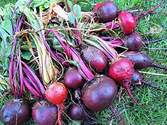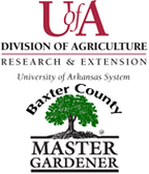|
Ozark Green Thumb BCMG Monthly e-Newsletter |
|
|
 I grew up eating beets, but only the pickled kind from the Mason jars my mother canned in considerable quantity. Nowadays I can’t pass them by at a salad bar where they seem to have taken up permanent residence. Since my youth I’ve encountered stewed beets -- OK but not great-- and on a trip to Russia, borscht, which quickly became a favorite. Beets (Beta vulgaris), though a humble root vegetable, have an interesting history. Beets have been domesticated about 4,000 years, probably first brought into cultivation as a leafy green around the Mediterranean basin. The plant has long been classified as belonging to the chenopod family, the same family to which spinach belongs, but new classification schemes using DNA data have moved this whole family into the amaranth family. Chard, a leafy selection of the beet, seems to have been displaced as a common greens crop by spinach when it became more widely grown. Beet plants are biennial herbs that are usually grown as annuals. They form a large inflated tap root and leafy rosette of leaves that bolt in the early summer of the second season and produce a tall growing stem containing insignificant clusters of small flowers on 6-foot tall stems. From the gardener’s perspective, if the plant ever bolts and produces flowers, the optimum time for harvest has been missed. Taxonomically four principle subsets of this species are recognized; 1) chard which is grown for its edible leaves and does not produce a tap root, 2) mangel-wurzel, a beet root developed as a wintertime fodder for cattle 3) sugar beets for sucrose production and 4) table beets which, while primarily seen in bright red, are also available in golden yellow and white forms. The red/purple pigment associated with beetroot is from various betalains, water soluble pigments formed from an indole based pathway that are found in plants in the Caryophyllales order. This category of plant classification is an umbrella group housing many seemingly unrelated plant families such as cacti and beets. However, because beets, cacti and amaranth all have betalin pigments, logic dictates they must descent from some common ancestor that produced this kind of color pigment instead of the more common, but completely chemically unrelated anthocyanin pigment, found in other plants with red flowers or leaves. The red/purple pigment associated with beetroot is from various betalains, water soluble pigments formed from an indole based pathway that are found in plants in the Caryophyllales order. This category of plant classification is an umbrella group housing many seemingly unrelated plant families such as cacti and beets. However, because beets, cacti and amaranth all have betalin pigments, logic dictates they must descent from some common ancestor that produced this kind of color pigment instead of the more common, but completely chemically unrelated anthocyanin pigment, found in other plants with red flowers or leaves. Red table beets were taken to northern Europe during the years of Roman occupation where, until the 17th century they were known as “Roman beets.” Both the beetroot and the tops are edible with the leaves either cooked similar to spinach or eaten fresh as salad greens. They arrived in America with the earliest settlers but never gained much prominence as a crop until the middle years of the 18th century when a German scientist discovered that the sugar found in beets and sugar cane, sucrose, was the same. Ordinary table beets contain 2 to 6 percent sucrose but selection efforts quickly elevated the sugar beet sugar content to about 10 percent. The French, during the English-imposed blockade which stopped cane sugar shipments during the Napoleonic Wars, were the first to take advantage of this newly developed technology and opened the first sugar beet extraction plant in 1802. Sugar beets were imported to the United States in the 1830’s with the first extraction plant opening in California in 1879. Over the next century and a half the world supply of sugar has equaled out with half coming from cane and half from beets. Beets are easy to grow in the vegetable garden. Plant the seeds about 1.5 inches apart in a row about a month before the last frost date. Beet seed is actually a cluster of seeds bound together in a naturally occurring seed ball, so after emergence, seedlings should be thinned to 1.5 inches apart. Multiple plantings at four-week intervals will ensure continual production through the year. Beetroots continue to enlarge as long as they remain in the ground, but roots of a usable size can usually be produced in 60 to 70 days. By: Gerald Klingaman, retired
Retired Extension Horticulturist - Ornamentals Extension News - May 31, 2013
0 Comments
Leave a Reply. |
Archives
April 2022
|
|
